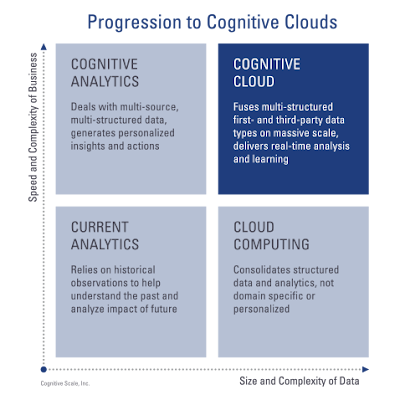Twitter Feed
Is Cloud Computing applicable in national security and law enforcement?
Late last week I asked the following question on linkedIn “Are Cloud Computing concepts applicable in secure national security and law enforcement arenas (i.e. Defense, Homeland Security, Intelligence, Justice)? If…
The size of Google’s Cloud
From The Information Factories by George Gilder of Wired Magazine “The facility in The Dalles is only the latest and most advanced of about two dozen Google data centers, which…
Yahoo (Finally!) Jumps Big Into Cloud Computing
According to The Register , the Yahoo! technology organization led by CTO Ari Balogh will now work on “developing a world-class cloud computing and storage infrastructure; rewiring Yahoo! onto common…
InformationWeek Cloud Computing Newsletter
InformationWeek has started a Cloud Computing Newsletter. They will be providing news and insights on this “critical IT trend”. Cloud computing ranges from the software-as-a-service market to Web-based storage services…
Is Cloud Computing just a fad?
Last week I attended an IBM SOA event in Northern Virginia. While there, I was discussiing the merits of cloud computing with some interested attendees. Their key question was if…
Joint Warfighting Conference 08
Last week I attended the Joint Warfighting Conference 08 (JWC 08) in Virginia Beach, Va. There were approximately 5000 attendees representing military, industry, academia, and government, registered for this year’s…
IBM Opens Africa’s First “Cloud Computing” Center
…… Second Cloud Center in China “IBM (NYSE: IBM) today announced the opening of new “cloud computing” centers in South Africa and China. Cloud computing enables the delivery of personal…
Dataline launches SOA-R: Cloud Computing for National Security Applications
Last week, Dataline (my company), in collaboration with IBM, Google, Northrop Grumman, Cisco and Great-Circle Technologies, launched an initiative aimed at integrating an end-to-end solution for secure cloud computing. Called…
Cloud Computing Value
In The real value of Cloud Computing, ENKI hits on why cloud computing is disruptive. It’s the services stupid !! By separating enterprises from their servers and offering universal, secured,…
How Cloud Computing Works
Jonathan Strickland provides an excellent overview of cloud computing on the how stuff works website. Follow me at https://Twitter.com/Kevin_Jackson
According to the IBM Institute for Business Value the market will see a rapid adoption of initial cognitive systems. The most likely candidates have moved beyond descriptive and diagnostic, predictive and routine industry-specific capabilities. 70 percent of survey respondents are currently using advanced programmatic analytics in three or more departments. In fact, the widespread adoption of cognitive systems and artificial intelligence (AI) across various industries is expected to drive worldwide revenues from nearly US$8.0 billion in 2016 to more than US$47 billion in 2020.
The analyst firm IDC predictsthat the banking, retail, healthcare and discrete manufacturing industries will generate more than 50% of all worldwide cognitive/ AI revenues in 2016. Banking and retail will each deliver nearly US$1.5 billion, while healthcare and discrete manufacturing will deliver the greatest revenue growth over the 2016-2020 forecast period, with CAGRs of 69.3% and 61.4%, respectively. Education and process manufacturing will also experience significant growth over the forecast period.
th’s ability to replicate intuitive experiences provides a number of opportunities within sentiment analysis. With its ability to understand scenes and context, it can decipher how people are feeling based off facial expressions or voice stress levels.
- Need robust and simplified data classification processes in order to more easily deliver industry and business model specific value;
- Require the implementation of information technology security controls that are driven by data value and role based access control paradigms; and
- Leverage software applications that should be developed using ISO 27034 which is a multi-part standard on specifying, designing/selecting and implementing information security controls through a set of processes integrated throughout an organization’s Systems Development Life Cycle/s (SDLC).
( Thank you. If you enjoyed this article, get free updates by email or RSS – © Copyright Kevin L. Jackson 2016)
Cloud Computing
- CPUcoin Expands CPU/GPU Power Sharing with Cudo Ventures Enterprise Network Partnership
- CPUcoin Expands CPU/GPU Power Sharing with Cudo Ventures Enterprise Network Partnership
- Route1 Announces Q2 2019 Financial Results
- CPUcoin Expands CPU/GPU Power Sharing with Cudo Ventures Enterprise Network Partnership
- ChannelAdvisor to Present at the D.A. Davidson 18th Annual Technology Conference
Cybersecurity
- Route1 Announces Q2 2019 Financial Results
- FIRST US BANCSHARES, INC. DECLARES CASH DIVIDEND
- Business Continuity Management Planning Solution Market is Expected to Grow ~ US$ 1.6 Bn by the end of 2029 - PMR
- Atos delivers Quantum-Learning-as-a-Service to Xofia to enable artificial intelligence solutions
- New Ares IoT Botnet discovered on Android OS based Set-Top Boxes



